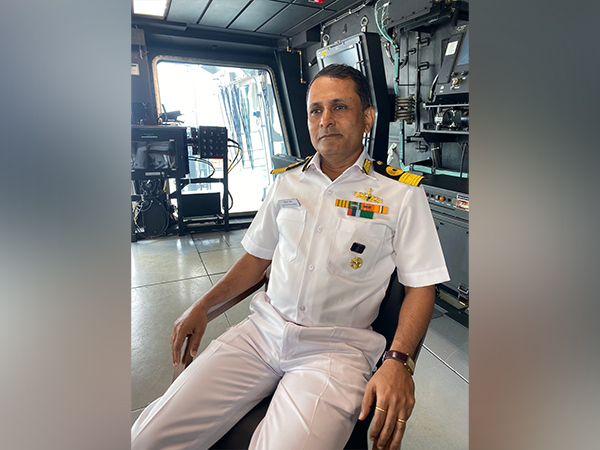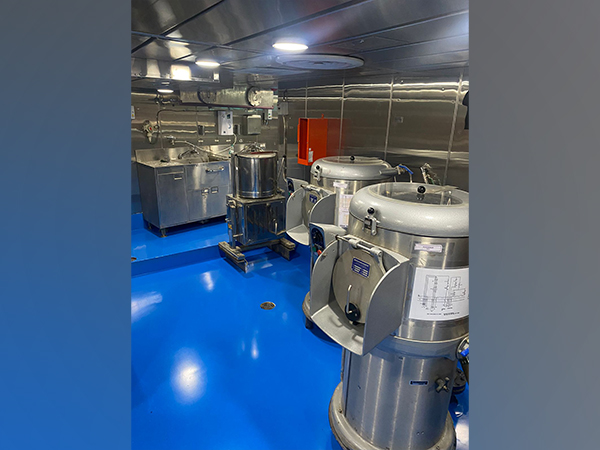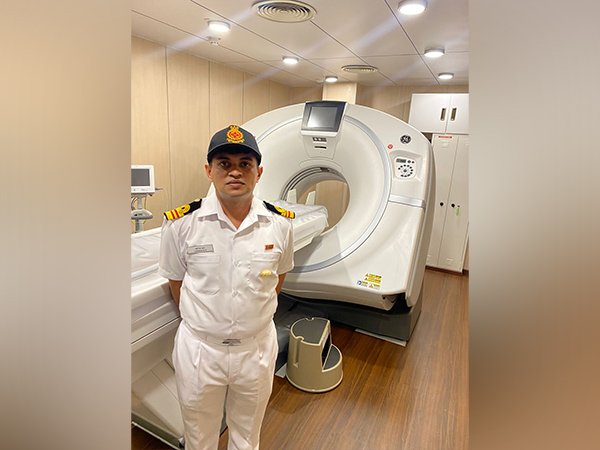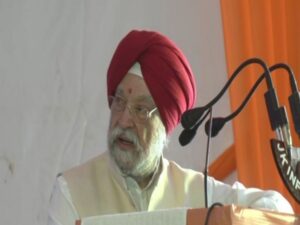
Onboard Vikrant/Kochi (Kerala) [India], August 23 (ANI): The commanding officer of India’s first indigenously-built aircraft carrier (IAC) Vikrant, Commodore Vidhyadhar Harke said the ship will provide unmatched capability and will act as a deterrence for any misadventure. “The Vikrant brings in capability which is unmatched and it would augment the present aircraft carrier, Vikram Aditya. it is a visible deterrence for any misadventure by anybody. When I say our maritime capability perspective plan is not against any country-specific, it is having our own capability,” Harke told ANI.
He explained that capability enhancement is required because of dependence on the blue economy as secure trade requires a strong navy.
“Capability is required because of our dependence on the blue economy as 90 per cent in volume and more than 70 per cent in value of our trade is sea-born. With the growing economy, we have been touted to be one of the leading economies in decades to come. The safety of our trade would be of paramount importance and any growing economy requires a strong navy,” Vikrant Commanding officer said.
Talking about the importance of Aatmanirbhar spirit in the Indian Navy, he said that the effort was not an overnight success as the country was striving on the path of self-reliance. “Here we have got a fantastic model wherein each equipment has got the original equipment manufacturer or the partners that we can call them those who are present in India. They can repair it and provide us with spare parts and upgrades. So I’m not tethered to some foreign person who can say ‘No, I will not be able to give you’, on the other side we have Indian partners working in tandem walking the talk and making it happen. That is Aatmanirbhar Bharat and that’s what it means to us,” Harke explains.
With Vikrant, India enters a club of select few countries which can design and construct its own aircraft carriers and the commanding officer feels it will be a stepping stone for the Navy to undertake the construction of more complex and bigger ships.
Vikrant was designed by the Indian Navy’s in-house Directorate of Naval Design (DND) and built by CSL, a Public Sector Shipyard under the Ministry of Ports, Shipping, and Waterways. The carrier is christened after her illustrious predecessor, India’s first Aircraft Carrier which played a vital role in the 1971 war.
The 262-meter-long carrier has a full displacement of close to 45,000 tonnes which is much larger and more advanced than her predecessor. The ship is powered by four Gas Turbines totalling 88 MW power and has a maximum speed of 28 Knots. Built at an overall cost of close to Rs 20,000 crores.
With an overall indigenous content of 76 per cent, IAC is a perfect example of the nation’s quest for “Aatma Nirbhar Bharat” and provides a thrust to Government’s ‘Make in India‘ initiative.
The ship would be capable of operating an air wing consisting of 30 aircraft comprising of MIG-29K fighter jets, Kamov-31, MH-60R multi-role helicopters, in addition to indigenously manufactured Advanced Light Helicopters (ALH) and Light Combat Aircraft (LCA) (Navy). (ANI)
IAC Vikrant’s total cabling length equivalent to distance between Kochi-Delhi, amount of steel used equals 4 Eiffel Towers
By By Sahil Pandey
Onboard Vikrant/Kochi (Kerala) [India], August 23 (ANI): India’s first indigenously-built aircraft carrier (IAC) Vikrant, which is soon to be commissioned, has a total cabling length of 2,400 kms which is equal to the distance from Kochi to Delhi, said Southern Naval Command chief Vice Admiral MA Hampiholi.
The Vice Admiral said that the amount of steel used in the ship is equivalent to four times the steel used in the making of the Eiffel Tower.
Giving the analogy for the specifications of Vikrant, Vice Admiral Hampiholi told ANI, “Just to give an idea the amount of steel which has been used in the ship is enough to perhaps make four Eiffel Towers. The ship’s cabling runs almost about 2,400 kilometres which is roughly the distance between Kochi to Delhi. Each of the MIG 29K aircraft stationed on Vikrant weighs as much as about two African elephants.”
Vice Admiral Hampiholi mentioned that the ship generates enough electricity to power a small town. He further pointed out that Vikrant travels close to about 28 knots. The Indian Navy had on July 28 taken delivery of the carrier from CSL after it had successfully completed the fourth and the final phase of the sea trials last month.
With the delivery of Vikrant, India has joined a select group of nations having the niche capability to indigenously design and build an aircraft carrier. IAC Vikrant has over 2,300 compartments, designed for a crew of around 1,700 people.
Vikrant equipped with automated galley, capable of producing 5,000 meals a day serving 1,700 sea warriors

India’s 1st indigenously-built aircraft carrier Vikrant has three automated galleys to prepare food for sea warriors and it has capability to produce 5,000 meals a day in every situation. 29-year-old logistics officer Lieutenant Commander Ankit Saraswat told ANI, “We have 3 galley overall and they are capable of producing 5,000 meals a day. Catering to 1,500-1,700 personnel. Staff work for almost 20 hours a day.”
Talking about the equipment for food production on board, Lieutenant Commander said the automated galleys have machines for chapati making, preparing bakery items, Dosa maker and boilers for rice, lentils and curries. “Onboard we have advanced equipment like chapati making machine which can prepare 6,000 chapatis per meal. We have steamers to prepare bakery items like bread loaf, croissants, cake. We have Dosa making machine as well. We also have boilers which can be used to prepare 400 Kgs of Rice, Dal, curries as well,” he added.
Saraswat pointed out that the supporting equipment are installed in the galley like dough needing machine and vegetable cutting machine for making large-scale meal preparation. “Most of the galleys are automated and are functioning systematically. Galleys have to function in all kinds of situations– operational situation or peaceful situation,” Saraswat explained. The Indian Navy had on July 28 taken delivery of the carrier from CSL after it had successfully completed the fourth and the final phase of the sea trials last month. Vikrant can stock 100 tonnes of ration and have 50 cooks onboard to prepare the meals. (ANI)
IAC Vikrant equipped with 16-bed hospital, 2 operation theatres to cater medical emergencies

Onboard Vikrant/Kochi (Kerala) [India], August 23 (ANI): Vikrant, the indigenous aircraft carrier soon to be commissioned into the Indian Navy, consists of a mini hospital with 16 beds, two operation theatres and for the first time, a CT scan machine. These will be installed on the ship which will cater to every medical emergency on board.
The medical officer posted on Vikrant, Lieutenant Commander Harsha MR, told ANI: “Vikrant has a primary medical complex and we have more than 40 compartments spread over the entire ship. We have a 16-bed hospital with all the facilities such as laboratory, CT scan, ultrasonography, X-ray as well as the blood transfusion department and two dental chairs and dental treatment facilities.”
He added that the strength of five officers and 16 Paramedics posted currently onboard can take care of all sorts of emergencies and complete care for all personnel.
Harsha mentioned that Vikrant will be the first ship to have a CT scan machine in India and also have two operation theatres. “This is the first-ever CT scan machine in warship as well as any ships related to India. This is the first time we have installed a CT scan machine over offload platforms,” Harsha said.
The Medical Officer on Vikrant highlighted the facility will be able to cater to all 1,600 sea warriors on the ship.
IAC Vikrant was tested in four trial phases, its fourth trial was completed on July 10. The Indian Navy had on July 28 taken delivery of the carrier from Cochin Shipyard Limited after it had successfully completed the final phase of the sea trials. With the delivery of ‘Vikrant’, India has joined a select group of nations having the niche capability to indigenously design and build an aircraft carrier. (ANI)












